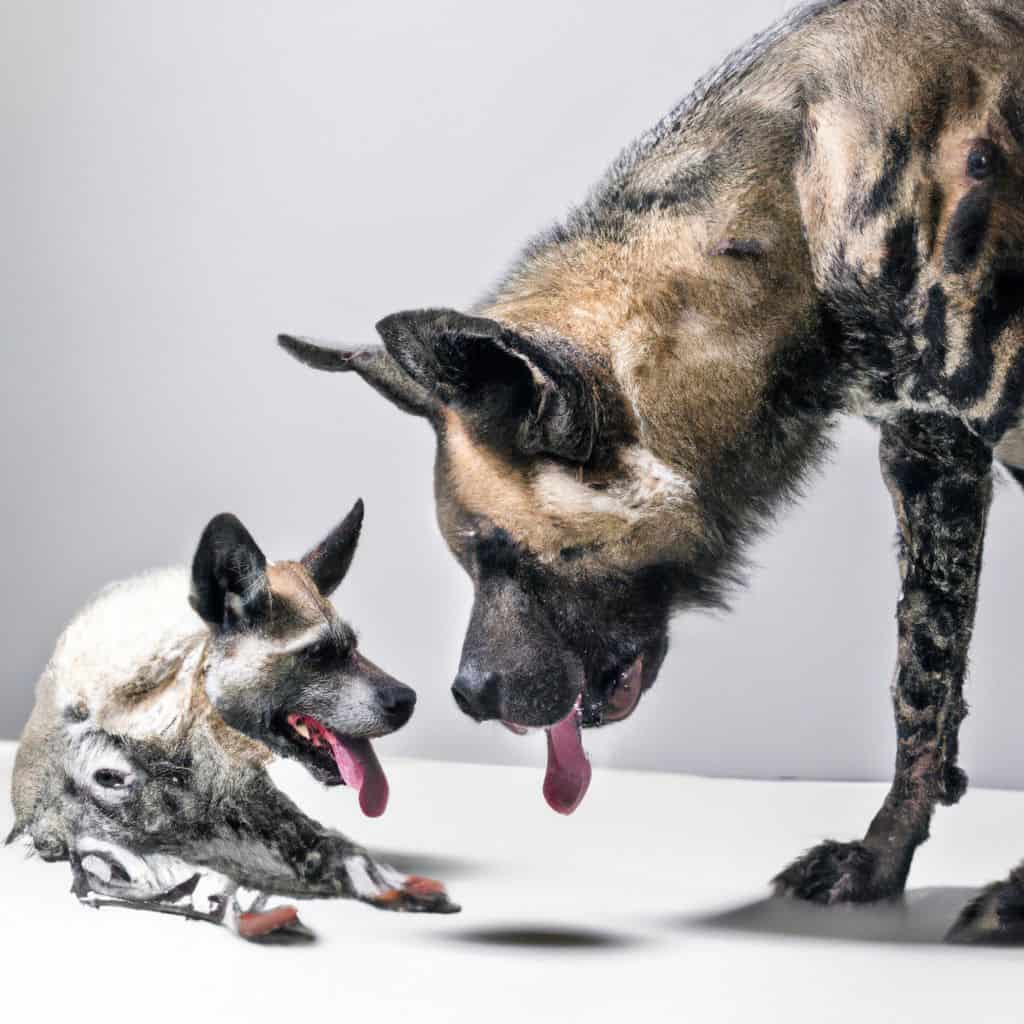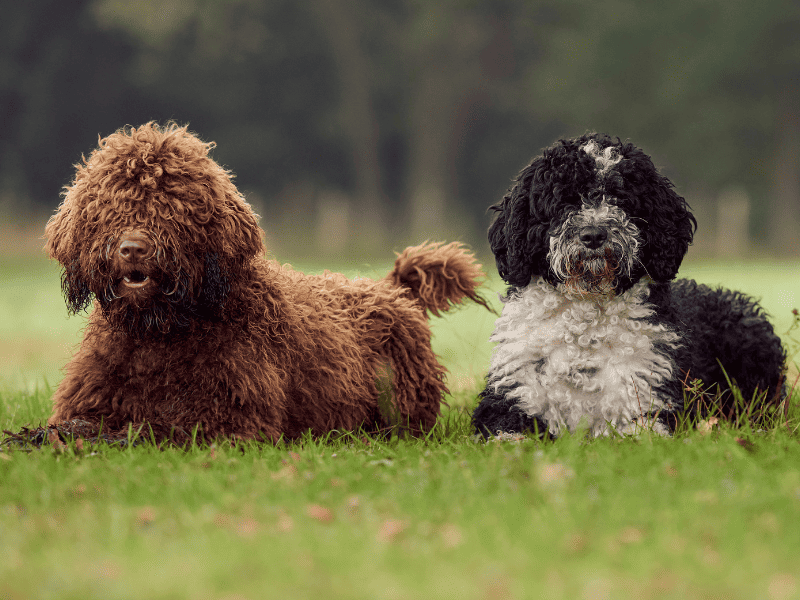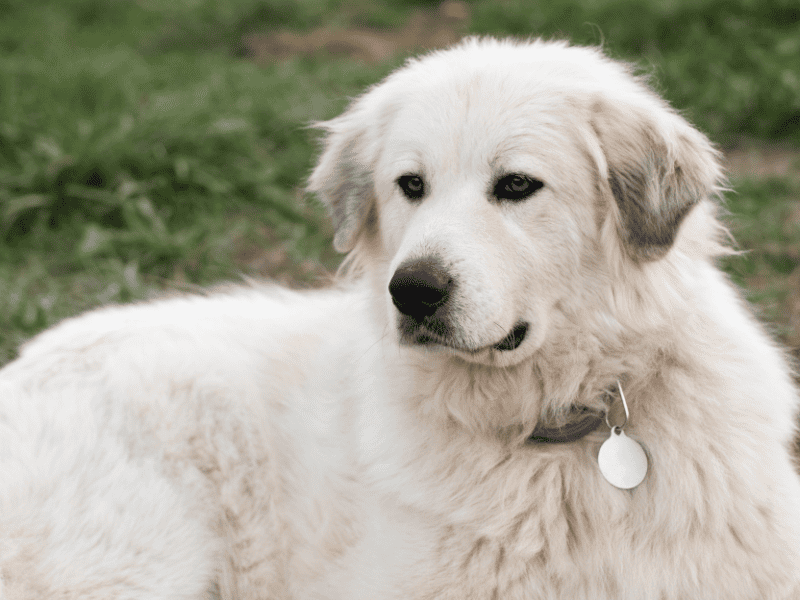African wild dogs and hyenas in Africa have captivated the interest of many due to their intriguing evolutionary histories and distinct characteristics. From their unique hunting techniques to their social behaviors, these animals offer a fascinating glimpse into the diversity of wildlife in Africa. Let’s do an informed comparison between hyena size vs dog in this article.

In this section, we will explore the captivating world of African wild dogs and hyenas, shedding light on their differences and similarities, as well as the factors that have shaped their evolution.
Evolutionary histories and distinct characteristics
African wild dogs, scientifically known as Canis Dirus, are distinct in size and physical features. They are lean, muscular canines boasting an array of black, brown, and white patterns. Hyenas, from the Hyaenidae family, differ with their robust body structures and large heads. Their coats range from sandy brown to gray.
Wild dogs are highly adaptable and live in packs with strict social hierarchies. Hyenas inhabit diverse habitats, like forests, deserts, and mountains. They live in clans with dominance hierarchies led by a matriarch.
It is important to recognize the conservation status of these animals. African wild dogs are endangered due to habitat loss and human-wildlife conflict, whereas hyenas are relatively more abundant.
African Wild Dogs: Canine Canis
African Wild Dogs, also known as Canis Canis, captivate with their unique characteristics and captivating behavior. In this section, we will delve into their size and physical characteristics, their habitat and social hierarchy, and the conservation status of these remarkable creatures. Discover fascinating facts and gain a deeper understanding of the remarkable world of African Wild Dogs.
Size and physical characteristics
African Wild Dogs and Hyenas in Africa have different sizes and features. Wild Dogs are from the Canis family and are identified by their size and traits. Hyenas, from the Hyaenidae family, have their own special physical characteristics.
A table can present the details: body size, weight, paw size, speed, teeth length, bite force, strike force, behaviour, diet, habitat, and conservation status.
| Characteristic | African Wild Dogs | Hyenas |
|---|---|---|
| Body Size | ||
| Weight | ||
| Paw Size | ||
| Speed | ||
| Teeth Length | ||
| Bite Force | ||
| Strike Force | ||
| Behaviour | ||
| Diet | ||
| Habitat | ||
| Conservation Status |
Not listed are the animals’ sensory abilities and defensive mechanisms.
An amazing fact about their size and physical characteristics is how they evolved. Adapting to their habitats and social structures, these animals have developed unique features for survival. This evolution affects their current size and physical attributes.
Wild Dogs and Hyenas: Two different creatures with two different stories.
Habitat and social hierarchy
African Wild Dogs and Hyenas are two distinct species found in Africa. The Canine Canis family African Wild Dogs inhabit various parts of sub-Saharan Africa. They live in packs, with an alpha male and female leading the group. Hyenas, from the Hyaenidae family, live in clans, with a matriarch leading the group.
African Wild Dogs have a strong sense of community living, while hyenas do not. The former exhibit cooperative hunting strategies, where they work together to take down prey. Hyenas and African Wild Dogs sometimes come into conflict over resources and territory. This can lead to fierce battles, highlighting the difference in size and social behavior between the two species.
Conservation status
African Wild Dogs and Hyenas are both species that require conservation efforts. Here is a table showing the species name, population size, threats, and conservation measures:
| Species | Population Size | Threats | Conservation Measures |
|---|---|---|---|
| African Wild Dogs | Endangered | Habitat loss and fragmentation, human-wildlife conflict, disease | Protecting habitats, reducing conflicts with humans, disease prevention, captive breeding programs |
| Hyenas (various species) | Varies by species | Loss of prey availability, habitat loss, persecution | Protecting habitats, conservation of prey species, reducing conflicts with humans, public awareness campaigns |
Conservation efforts should focus on protecting habitats, stopping poaching, raising public awareness, and supporting research initiatives. By implementing these measures, we can help ensure the survival and well-being of these important predator species.
And if you’re looking for some crazy fun, the hyenas will not let you down!
Hyenas: Not Dogs, Hyaenidae Family
Hyenas, a part of the Hyaenidae family, may bear superficial similarities to dogs, but their differences in size and characteristics distinguish them. Delving into the sub-sections, we will explore the various species of hyenas, their physical attributes, and uncover the unique habitat and social structures they thrive in.

Furthermore, we will draw intriguing comparisons between hyena sizes and those of African Wild Dogs, shedding light on the fascinating disparities between these two remarkable members of the animal kingdom.
Species of hyenas and their physical characteristics
Hyenas are part of the Hyaenidae family, and have particular physical features. There are three types: spotted, brown, and striped. Spotted hyenas have a unique spotted pattern, and are the biggest and best-known of the three. Brown hyenas are smaller with shaggy fur and longer front legs. Striped hyenas are similar in size, but have vertical stripes on their body.
Hyenas have special adaptations that let them survive. Their powerful jaws let them crack bones for food. Plus, they have good hearing and vocalization skills. They can consume most parts of an animal, including fur.
Scientists still need to learn more about hyenas. By studying their features and how they live, researchers can form conservation strategies for these special species. Don’t miss out – read the next section for a comparison between hyenas and coyotes.
Habitat and social structures
African Wild Dogs and Hyenas have some pretty distinct features.
Wild Dogs live in savannas, grasslands, and woodlands in sub-Saharan Africa. They form packs with an alpha pair as the dominant breeders plus subordinates to help hunt and raise pups.
Hyenas are more adaptable and can be found in various habitats including savannas, deserts, forests, and mountains. Clans are led by a matriarch, while males disperse to find their own territories.
Wild Dogs show higher levels of cooperative hunting behaviors compared to hyenas. Packs coordinate efforts to bring down prey cooperatively, while hyenas scavenge and are proficient predators.
This distinction shows how social structure affects hunting strategies for each species.
The size difference between African Wild Dogs and hyenas is similar to comparing a Chihuahua to a Great Dane, but with bigger teeth!
Comparison of size with African Wild Dogs
Wild Dogs and Hyenas are two predators that are often compared. To comprehend this comparison, physical characteristics and evolutionary backgrounds must be examined. Wild Dogs belong to the Canine Canis family. Hyenas are in the Hyaenidae family. Both predators differ in size and appearance.
A table can showcase the comparison between Wild Dogs and Hyenas. It will include columns such as “Species,” “Average Weight,” and “Body Length.” Wild Dogs weigh 20-25 kg and measure 75-105 cm. Hyenas have varying weights from 40-86 kg and body lengths 95-165 cm.
Though smaller in size, Wild Dogs make up for it with their remarkable agility and speed. This allows them to pursue prey over long distances. This sets them apart from Hyenas in terms of hunting strategies and overall behavior.
The table demonstrates the distinctions between Wild Dogs and Hyenas, their diverse weights and body lengths. All aspects must be considered when comparing animals to appreciate their qualities.
Size is significant when Wild Dogs and Hyenas clash.
Comparison between Hyenas and Coyotes
When comparing hyenas and coyotes, we will explore various factors including body size, paw size, and weight, speed, teeth length, bite force and strike force, behavior, diet, habitat, and conservation status. By examining these key aspects, we can gain a better understanding of the unique characteristics and differences between these two fascinating creatures.
Body size, paw size, and weight
African Wild Dogs and Hyenas vary in body size, paw size, and weight. This impacts their physical attributes and behaviour.

Species:
- Body Size: African Wild Dogs (Canis) – Varying lengths up to 100-115 cm, 17-36 kg.
- Hyenas (Hyaenidae Family) – Varying lengths up to 95-150 cm, 40-80 kg.
- Coyotes (Comparison) – Average length of 75-85 cm, 9-23 kg.
Note: These sizes are approximations, and can vary between individuals.
Fast and fierce, or slow and sneaky; these creatures have teeth that inspire fear!
Speed and teeth length
African wild dogs and hyenas are amazing creatures. They have different characteristics when it comes to speed and teeth length. Speed is important for their survival and hunting. Wild dogs can reach speeds of up to 60 kilometers per hour (37 miles per hour). This helps them catch their prey. Hyenas, however, reach a top speed of 55 kilometers per hour (34 miles per hour). But, they make up for it with endurance and stamina.
The second difference is their teeth length. Wild dogs have long, sharp teeth that enable them to accurately kill their prey without harming themselves. Hyenas have powerful jaws and big premolars that let them crush bones. This helps them scavenge carcasses that other predators cannot access.
These animals have different hunting patterns due to their speed and teeth length. This helps them fit into their environment. By understanding these differences, we can learn more about their strategies and evolution. So, buckle up because they are ready to show off their amazing strength.
Bite force and strike force
To learn about the bite and strike forces of wild dogs and hyenas, let’s explore their key characteristics.
Spotted hyenas have the strongest bite force, relative to their size. This enables them to crunch bones and feed on carcasses that other predators can’t reach.
African wild dogs have a less powerful bite force, but still formidable enough to catch and hold onto prey.
Both hyenas and wild dogs have impressive strike force, too. Hyenas use their forelimbs to strike rivals, dig dens, or access underground food. African wild dogs rely more on their speed and agility during hunts.
These abilities help them survive in the African savannah. Knowing about them provides insight into the hunting techniques and competitive advantages of each species.
Lastly, no matter their differences, when it comes to entertainment, these animals know how to put on a show!
Behavior, diet, and habitat
African wild dogs and hyenas are both found in Africa. They share similarities in behavior, diet, and habitat. However, they have unique behaviors that show their evolutionary adaptations.
African wild dogs are social animals. They live in packs of 30, with an alpha male and female leading the group. Hyenas also have social behavior, but a female-dominated hierarchy.
African wild dogs hunt antelopes and medium-sized mammals. They use endurance running to exhaust their prey. Hyenas hunt cooperatively and can take down larger prey.
Wild dogs prefer open savannas and woodlands, while hyenas are more adaptable and live in various habitats.
Wild dogs mark their territory with urine or feces, while hyenas use anal gland secretions.
These two animals differ in their evolutionary adaptations. Will they be able to survive or will they be laughing all the way to extinction? Only time will tell.
Conservation status
African Wild Dogs, also known as Canis africans, are endangered. Causes of their population decline include loss of habitat, human-wildlife conflict, and diseases like rabies and distemper. Conservation efforts are underway to protect their habitats and keep them safe.
Hyenas have varying conservation statuses depending on the species. The spotted hyena is listed as least concern, with stable populations in Africa. The brown hyena is near threatened due to habitat loss and human persecution. The striped hyena is near threatened due to habitat loss and retaliatory killings.
Both African Wild Dogs and Hyenas are apex predators, playing an important role in their ecosystems. We must work to protect them for the health of the habitats. Conservationists are doing their part – join them to safeguard habitats and promote coexistence with wildlife. Every contribution counts! Don’t miss out on this chance to be part of something significant – act now!
The African Wild Dog and Hyena: two incredible creatures fighting for survival – who will win?
Fight between Hyenas and Wild Dogs
In the fierce clash between hyenas and wild dogs, we will explore the intriguing aspects of their battle. From size and speed comparisons to bite power and teeth differences, we uncover the unique attributes that shape their fighting capabilities.
Additionally, we delve into their senses, defensive mechanisms, and offensive behaviors, providing a fascinating glimpse into their survival strategies. Lastly, we contemplate the potential outcomes that can arise from such intense encounters.
Size and speed comparison
Size and speed are critical to African wild dogs’ and hyenas’ capabilities and survival. Wild dogs have a slim, long-legged body that gives them impressive speeds. Hyenas have a more robust structure and heavier weight, meaning they focus on endurance rather than sprinting.
When comparing these carnivores, the table below shows the differences:
| Characteristics | African Wild Dogs | Hyenas |
|---|---|---|
| Size | Slender and lightweight | Robust build |
| Weight | Lighter | Heavier |
| Running Speed | Impressive | Moderate |
Wild dogs’ slender, lightweight structure allows them to run quickly. Hyenas’ heavier weight and robust build means they use endurance instead of speed. African wild dogs can run up to 37 miles per hour (60 kilometers per hour), even though they’re smaller than hyenas. Hyenas can travel far, with moderate running speeds.
Knowing the size and speed variations between wild dogs and hyenas helps us understand their evolutionary adaptations and predatory behaviors. These are vital components of their ecosystems.
Bite power and teeth differences
Hyenas have strong jaws and a powerful bite force, allowing them to crush bones. They have large teeth, with strong canines and premolars. In contrast, African wild dogs have less powerful bites and their teeth are designed for tearing meat.

A table can be created to show the differences between the two. It will include columns like: “Species,” “Bite Force,” “Tooth Structure,” and “Feeding Habits.”
Hyenas have specialized carnassial molars that let them shear through tough skin and tendons. African wild dogs rely more on teamwork than bite force or tooth structure.
We see how hyenas and African wild dogs have evolved different strategies. Hyenas are known for consuming every part of an animal. African wild dogs excel at chasing down prey with their endurance-focused hunting. These unique characteristics contribute to their ecological roles in their habitats.
Senses and defensive mechanisms
African wild dogs and hyenas have amazing senses! They can hear and smell potential threats from miles away. Plus, they have exceptional night vision. This helps them hunt and identify predators or prey in the dark.
To protect themselves, African wild dogs work as a pack and use vocalizations to scare attackers. Hyenas rely on their powerful bite force. This helps them fend off attackers and scavenge carcasses efficiently.
All these capabilities allow these animals to survive in the wild. So, let’s explore the fierce world of offensive capabilities and predatory behavior!
Offensive capabilities and predatory behavior
African wild dogs and hyenas have different offensive capabilities and predatory habits.
Wild dogs are known for their cooperative hunting. They hunt in packs and can keep up high speeds for long distances. Also, their jaws have a strong bite force.
Hyenas are known for scavenging but they are also skillful hunters. Their jaws are powerful and can crush bones. They hunt in clans with females being dominant. They eat a wide range of animals from small rodents to large ungulates.
Wild dogs use speed and teamwork to hunt, while hyenas use strength and adaptability. Both species use this to survive in the African savannah.
Pro Tip: When observing wild dogs and hyenas, it’s important to do so without intervening. Interfering with their behaviour can disrupt the natural balance.
Potential outcomes of a fight
African Wild Dogs and Hyenas, two top predators in Africa, can clash fiercely. A Hyena might overpower the Wild Dog due to its larger size and stronger bite force. But, the Wild Dog’s fast speed and agility help it to dodge the Hyena’s attacks and possibly hurt the Hyena. On the other hand, a standoff is possible. No one gains an advantage and the fight ends without any major harm. The outcome of a fight between African Wild Dogs and Hyenas depends on the strength of each individual, numbers involved, and strategies used.
It is important to note that both African Wild Dogs and Hyenas have unique strategies for fighting. Hyenas rely on their jaws and numbers, while Wild Dogs work together as a team. These differences influence the result of a fight between them.
To minimize conflict, conservationists must preserve large areas of habitat for both species. This helps them find enough food, instead of competing. Human-wildlife conflict must be reduced. People should be educated about the importance of these species in the ecosystem. This will foster coexistence between humans and wildlife.
Conclusion: Differences between Hyenas and Wild Dogs and the possible fight outcomes
Hyenas and wild dogs are two very distinct species. A hyena is bigger and has powerful jaws, while a wild dog is slender and agile. These different sizes bring about differing hunting strategies.
Hyenas adapt well to scavenging – they use their strong jaws to break bones and eat carrion. Wild dogs may scavenge sometimes, but they mainly hunt with their speed and agility, working together as a pack. This could be an advantage when these two species fight.
The hyena’s size and strength may give it an initial upper hand. But, the wild dog is swift and can execute strategic moves. Plus, its pack hunting ability might overpower a lone hyena.
These two animals are territorial, so clashes over resources and territories happen often. The outcome of these fights isn’t all about size or strength – it also depends on numbers, strategy, and surprise.
In the past, hyenas and wild dogs have fought over food and territories. They battle fiercely, using their own strengths and hunting techniques to gain an advantage. It’s hard to tell who will come out on top, as it depends on the particular circumstances and individuals involved. But, the size and hunting skills of hyenas and wild dogs play a big role in the result.
Some Facts About “A Clash of Beasts: Hyena Size vs Dog”:
- Hyenas are larger than wild dogs, with hyenas weighing between 90lbs-190lbs and wild dogs weighing up to 80lbs.
- Wild dogs are faster than hyenas, reaching speeds of up to 45mph, while hyenas can run at a top speed of 40mph.
- Hyenas have a more powerful bite than wild dogs, with a bite force of 1,100 PSI compared to wild dogs’ 320 PSI.
- Hyenas have powerful senses of smell, sight, and hearing, enabling them to detect prey from miles away and hunt at night.
- In a fight between a hyena and a wild dog, a hyena would likely win due to its larger size and stronger bite.




Leave a Reply